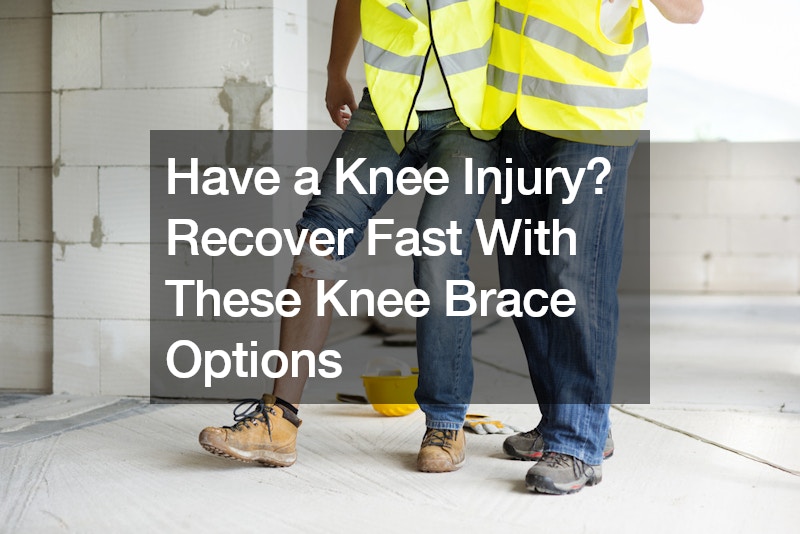Have a Knee Injury? Recover Fast With These Knee Brace Options

Knee injuries can be debilitating, affecting mobility and daily activities. Whether you’re dealing with arthritis, ligament tears, or recovering from knee surgery, finding the right knee brace can significantly aid in your recovery process. Knee braces provide support, stability, and pain relief, allowing you to regain mobility and resume your normal routine faster. Here are some knee brace options to consider for a speedy recovery:
-
General Pain Relief and Arthritis: For individuals experiencing general knee pain or arthritis, a compressive knee brace can offer much-needed relief. These braces provide compression to reduce swelling and alleviate pain, allowing you to move comfortably.
Look for knee sleeves with gel grips to prevent slipping during activity.
-
Ligament Tears: Ligament tears, such as ACL or meniscus tears, require specialized knee braces that offer stability and support. Braces with side stabilizers and hinges can help compensate for the lack of stability caused by the injury. These braces are crucial for preventing further damage and facilitating proper healing of the injured ligaments.
-
Post-Surgery Recovery: After undergoing knee surgery, whether it’s a knee replacement or meniscectomy, a supportive knee brace is essential for a smooth recovery. These braces are often prescribed by doctors and provide the necessary support to protect the healing knee joint. They help reduce pain and swelling while promoting proper alignment during the recovery process.
Shopping for Knee Braces: When shopping for knee braces, consider factors such as fit, comfort, and durability. Ensure that the brace provides a snug fit without restricting movement or causing discomfort. Look for braces with adjustable straps or sizing options to customize the fit according to your needs.
Online shopping offers a convenient way to browse a wide range of knee brace options. Many online retailers provide detailed product descriptions and sizing guides to help you make an informed decision. Additionally, some retailers offer flexible return policies, allowing you to exchange the brace if it doesn’t fit correctly.
Choosing the Right Knee Brace: Ultimately, the best knee brace for you will depend on your specific knee condition and personal preferences. If you’re unsure about which brace to choose, consult with a healthcare professional or orthopedic specialist for guidance. They can recommend the most suitable knee brace based on your diagnosis and treatment plan.
Knee braces come in various types, each tailored to address specific knee conditions, injuries, or preventive measures. Here are the most common types:
-
Knee Sleeves : Knee sleeves are lightweight, stretchy garments that provide compression and warmth to the knee joint. They are commonly used for general knee pain, mild arthritis, or to enhance blood circulation during physical activities. Knee sleeves are not typically recommended for significant ligament injuries or post-surgery recovery.
-
Hinged Knee Braces : Hinged knee braces are characterized by metal or plastic hinges on the sides of the brace. These hinges provide stability and support to the knee joint, making them suitable for individuals with ligament tears, such as ACL (anterior cruciate ligament) tears, or meniscus injuries. Hinged knee braces help prevent excessive sideways or rotational movements that could further damage the injured ligaments.
-
Post-Surgery Knee Braces : Post-surgery knee braces are prescribed by healthcare professionals to aid in the recovery process following knee surgery, such as knee replacement, meniscectomy, or ligament reconstruction. These braces offer protection, immobilization, and controlled movement to the knee joint during the initial stages of healing. They help reduce swelling, prevent excessive bending or stretching of the knee, and promote proper alignment for optimal recovery.
-
Patellar Stabilizing Braces : Patellar stabilizing braces, also known as patellar straps or patellar sleeves, focus on stabilizing the kneecap (patella). They are designed to alleviate pain and discomfort associated with conditions like patellar tendonitis, patellofemoral pain syndrome, or patellar instability. These braces typically feature straps or buttresses that apply pressure to the patellar tendon or support the patella in proper alignment.
-
Prophylactic Knee Braces : Prophylactic knee braces are preventive braces commonly used by athletes engaging in high-impact sports or activities prone to knee injuries. These braces aim to reduce the risk of ligament sprains or tears, particularly in the ACL, by providing additional support and stability to the knee joint. Prophylactic knee braces are often made of rigid materials and may restrict some movement to protect against sudden or excessive forces on the knee.
Overall, the choice of knee brace depends on the individual’s specific knee condition, injury severity, activity level, and recommendations from healthcare professionals.
In conclusion, knee braces are valuable tools for recovering from knee injuries and surgeries. Whether you’re dealing with arthritis, ligament tears, or post-surgery recovery, there are knee brace options available to meet your needs. Take the time to research and choose the right knee brace for your condition, and don’t hesitate to seek professional guidance if needed. With the right knee brace and comprehensive treatment plan, you can recover faster and regain mobility and independence.
.

